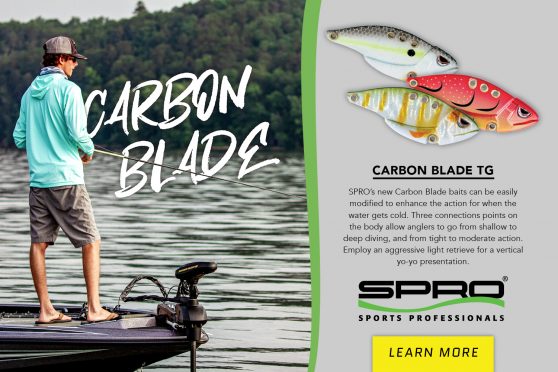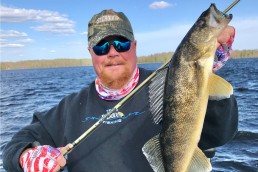Better Late Than Early Walleyes
SHARE THIS POST
 Early spring walleye tips from author Brian Brosdahl.
Early spring walleye tips from author Brian Brosdahl.
With our short, mild winter this year came less ice thickness and snow that will lead to early lake vegetation development, not to mention earlier spawning walleyes.
While anglers throughout Minnesota are excited to catch spring walleyes in their favorite opening day spot, keep in mind it may be a little different this year. The Minnesota in-land season walleye opener is May 15, 2021. This is four days later than last year. The ice went out an average of two weeks earlier in 2021.
There won’t be drastic changes in walleye behavior, although the walleyes will be more active and larger fish will be caught. Anglers will notice fish showing up on mid lake humps and weed beds. Walleyes are capable of utilizing many different types of habitat depending on where all the baitfish are holding.
Find the edge of the cabbage using the Side Imaging screen on your fish finder. Identify the length of the edge and mark corners and points to see fish along the way. This saves time in the long run to look first and fish later. This is helpful in gathering information on the best spot to approach by controlled drifting, Spot-Lock anchoring or slow trolling with a jig and a minnow.
In the spring most of the lakes I fish have spottail shiner minnows as a natural forage. Some lakes nearby only have small perch, emerald shiners, golden shiners, or some type of dace minnows available in each lake. But, whatever the predominant forage, minnows are key in spring.
When anglers are targeting walleyes in the weeds, it’s good to run a lighter jig head, such as a 3/16-ounce Northland Long Shank Fireball or Deep V Jig, to keep your jig from plowing through. I hook a minnow differently on long shank jigs: I put the hook in the mouth of the minnow, it comes out the chest, I push the collar up to the mouth and push through the bottom side to its back. This keeps your minnow on straight, and relatively weedless and all while bringing the tip of the jig back farther for short-biting walleyes. Minnows, especially shiners, can be hard to find because bait shops sell out of them quickly.
Keep in mind that fatheads, rainbows, and small sucker minnows will also work. Leeches or half a nightcrawler on a Northland Buckshot short shank stand-up or Round Head Fireball Jig can also, in many cases, be a secret go-to presentation.
Are you enjoying this post?
You can be among the first to get the latest info on where to go, what to use and how to use it!
Windswept points are productive for walleyes this time of year on large bodies of water; waves crashing through create a recirculating current or seiche. No matter how light the temporary lake current, walleyes will be there with the feedbag on. Keep your jig and minnow in the target zone, at the top of the rocks, tapping as you pass through on a controlled drift. But, keep in mind that allowing too much line out will lead to snags as your fishing line is flossing between the rocks. For example, on a slow drift in 10 feet of water you should have out 10 feet of line from the tip of your rod to your jig, with a rod tip a foot or two above water line.
I like to use a 7-foot St. Croix Legend Elite medium extra fast with Sunline SX1 braid with a double Uni knot attaching a 2- to 3-foot section of 8-pound Shooter fluorocarbon leader to the jig. I will lighten to a St. Croix 7-foot medium light extra fast if I am jigging a leech or nightcrawler, so as not to snap the soft bait off my hook. In stronger winds, I will use a 6-foot rod in aforementioned actions; the shorter rod has less wind draw bearing down on it.
Other vegetation besides cabbage to key in on for walleyes is chara, a gray green skeletal like grass that grows in hard bottom areas. Chara algae has little micro branches without roots and the weed can roll like a tumble weed in the desert. It will gather up in some spots and thin down in other areas form current, boat anchors, and waves. This gives walleyes another pillowy weed edge to hunt prey.
Northern milfoil and Eurasian water milfoil grow vine like branches that are covered with green leaflets. Northern milfoil is natural and grows in little clumps around the lakes. It’s easy to fish and walleyes hold to it like a small hump or structure. Eurasian water milfoil is an invasive species that looks similar but grows to the surface. Walleyes love it, hanging on its growing edges.
Another solid presentation is to use slip bobbers with a leech or minnow. I like to utilize a Gamakatsu Octopus style #4 red or neon-colored hook to rig the live bait. A jig tied on under a slip bobber also works well for fishing the edges of vegetation. Let the fish cruise to you.
Anglers, don’t forget to bring crankbaits. They work well in the same areas already mentioned. Slow troll the weed edges or pitch and twitch. You might be surprised at how effective they are, especially with a stable barometer. I will have some of my favorite Northland Rumble Shiners and Rumble Shads ready to throw.
If you enjoy walleye fishing, you’ll find lots of tips and information in every issue of MidWest Outdoors, available the first full week of each month at the newsstand or by subscribing on our website.
MWO
SHARE THIS POST
You may also like...
Nothing found.
Did you enjoy this post?
You can be among the first to get the latest info on where to go, what to use and how to use it!
Brian 'Bro' Brosdahl
Outdoor communicator Brian “Bro” Brosdahl lives in northern Minnesota. He is a walleye guide in the Cass Lake, Leech Lake and Lake Winnibigoshish areas. He is sponsored by Northland Fishing Tackle, Frabill/Plano, Aqua-Vu, Humminbird/Minn Kota, St. Croix Rods, Ranger Boats, and Evinrude. Guide inquiries: brosguideservice.com. Follow on social media.
